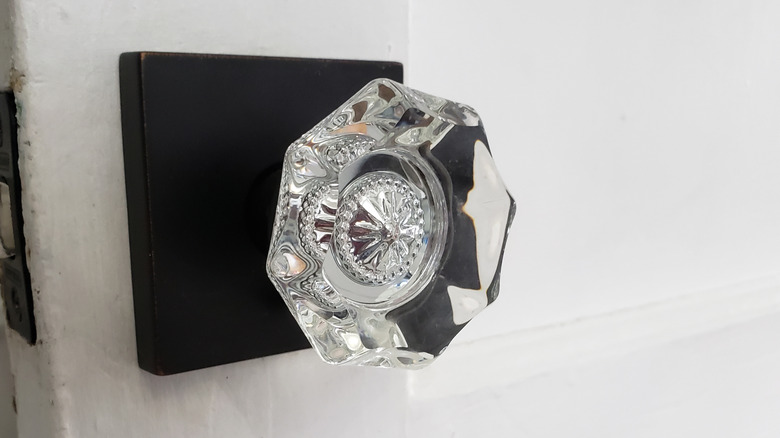How To Identify Crystal Doorknobs
Crystal doorknobs are not made from quartz crystals — they are made from glass. All the rage in the first 30 years of the 20th century, molded glass and cut-glass crystal doorknobs first appeared in the beginning of the 19th century. Manufactured to last — which makes them prized possessions when you can find them — crystal glass doorknobs have a solid metal shank and mount. You can also buy reproductions made with glass or plastics and cheaper metal alloys, but identifying real glass crystal doorknobs starts with holding one in your hand to get its feel.
Glass Doorknobs
The process of making glass doorknobs began in 1826, but they didn't catch on until 1917, after the U.S. entered World War I. Before that time, metal alloy doorknobs were more common, but the war caused a shortage of metal that allowed the crystal doorknob to gain center stage. Glass comes from a formula mostly composed of sand, which melts and becomes transparent when heated to extremely high temperatures, so there was and still is an ample supply. In its liquid state, the glass was poured into molds of various designs and shapes to form the doorknobs, and some were cut to form their crystalline shapes.
Crystal Doorknob Designs
Crystal doorknobs made from glass feel different in the hand than reproductions do, because they're a bit heavier thanks to the glass itself and metal mounts and shanks. Many antique crystal doorknobs were clear and cut to have six, eight or 12 facets, or faces, with the look of a large diamond. Some knob heads are flat, through which you can see designs molded into the base of the knob in shapes of bullets, stars or pin pricks. Others may look like an amber faceted bug's eye or have a long angular, crystalline appearance. The glass of antique knobs has a liquid, almost watery look compared with modern reproductions. Some even had etched monograms.
Colored Crystal Doorknobs
More rare than clear-glass doorknobs are the cobalt blue and robin's egg blue knobs, or colors such as milky white, yellow-green, emerald green, amber or violet — if you can find any of these, you're lucky. Some crystal doorknobs contain silver nitrate on the inside, giving them a mirrored appearance. On both clear and colored crystal knobs, look for heavy, weighty metals such as brass or steel, which may appear dark because of age and discoloration.
Hardware Identification
There are more than 100 patterns to choose from in antique crystal doorknobs, and the shanks and spindles differ somewhat based on when they were made. Crystal doorknobs manufactured before 1900 include a spindle without threads, with holes in the ends meant for inserting a rod through, secured with small flush screws. Knobs made after this time have square shanks with threads inside that fit square spindle door hardware. Many of the earlier plates — escutcheons — contained a lot of scroll work and designs.
Buyer Considerations
When you're redecorating a period house and need to find crystal doorknobs, take one of the original doorknobs with you if possible. Verify the antique doorknob does not twist on its shank before purchase, as this cannot be fixed. You can identify the difference between reproduction crystal doorknobs and antique ones by also looking at the metal. Modern reproductions include brittle, cheap metals and don't have the same quality or feel when you hold them or look into the crystal. When adding a crystal doorknob to your home, be aware that it acts like a magnifying glass when sunlight passes directly through it, and this can start a fire.
